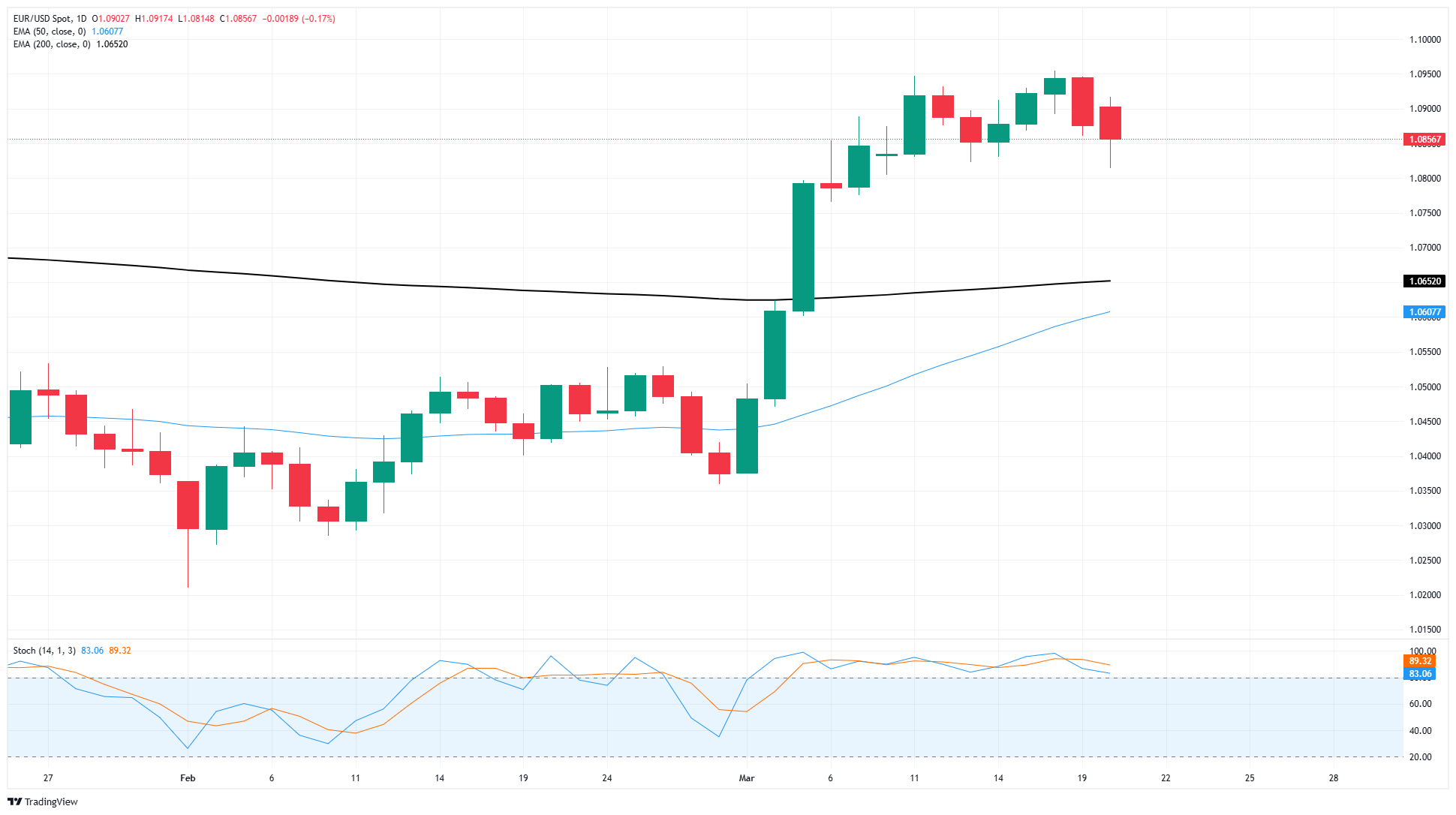EUR/USD eases on Thursday, slipping below 1.0900 once again
- EUR/USD sheds 0.2% to fall back below the 1.0900 handle on Thursday.
- Market sentiment remains subdued overall as investors recover from Powell glut.
- Fiber markets have snapped a recent win streak as the Euro falls back for a second day.
EUR/USD backslid for a second consecutive trading day, falling one-fifth of one percent on Thursday as markets continue to keep one foot in the safe haven US Dollar amid still-bubbling market tensions around the US’s waffling on tariff policy.
Federal Reserve (Fed) Chair Jerome Powell downplayed economic pitfalls at the hands of US President Donald Trump’s tariff threats that seem to exist in a quantum state where they both exist and do not exist simultaneously. According to Fed Chair Powell, downside risks have certainly elevated thanks to on-again, off-again tariff threats, but Fed policymakers continue to insist that US economic data remains healthy, albeit off of recent highs.
The Philadelphia Federal Reserve (Fed) Bank’s Manufacturing Survey for March eased to 12.5 MoM, falling from the previous month’s 18.1 and declining for the second month in a row, but pulling the brakes and falling less than the median market forecast of 8.5. US weekly Initial Jobless Claims also rose slightly less than expected, clocking in at 223K net new jobless benefits seekers compared to the previous week’s 220K. Investors had expected a print of 224K. US Existing Home Sales also rose nearly a third of a million more transactions than expected, rising to 4.26 million units moved in February compared to January’s revised 4.09 million. Market watchers had expected a slight slowing to 3.95 million.
there is little of note on Friday's economic data docket, leaving investors to grapple with and digest the week's events. Traders will also be keeping an eye out for any social media developments from President Trump. Donald Trump has made a habit of sending major proclamations into the void during Friday afternoons, prompting significant market reactions to both end the current week and kick off the next one, even though the majority of President Trump's statements have an iffy track record of coming true.
EUR/USD price forecast
EUR/USD shed weight for a second day, trimming another 20-odd pips and dragging the major pair back below the 1.0900 handle. Price action is drifting into rough sideways chop as directional momentum bleeds out of the charts, but near-term bidding action remains supported by 1.0800.
EUR/USD daily chart
Euro FAQs
The Euro is the currency for the 19 European Union countries that belong to the Eurozone. It is the second most heavily traded currency in the world behind the US Dollar. In 2022, it accounted for 31% of all foreign exchange transactions, with an average daily turnover of over $2.2 trillion a day. EUR/USD is the most heavily traded currency pair in the world, accounting for an estimated 30% off all transactions, followed by EUR/JPY (4%), EUR/GBP (3%) and EUR/AUD (2%).
The European Central Bank (ECB) in Frankfurt, Germany, is the reserve bank for the Eurozone. The ECB sets interest rates and manages monetary policy. The ECB’s primary mandate is to maintain price stability, which means either controlling inflation or stimulating growth. Its primary tool is the raising or lowering of interest rates. Relatively high interest rates – or the expectation of higher rates – will usually benefit the Euro and vice versa. The ECB Governing Council makes monetary policy decisions at meetings held eight times a year. Decisions are made by heads of the Eurozone national banks and six permanent members, including the President of the ECB, Christine Lagarde.
Eurozone inflation data, measured by the Harmonized Index of Consumer Prices (HICP), is an important econometric for the Euro. If inflation rises more than expected, especially if above the ECB’s 2% target, it obliges the ECB to raise interest rates to bring it back under control. Relatively high interest rates compared to its counterparts will usually benefit the Euro, as it makes the region more attractive as a place for global investors to park their money.
Data releases gauge the health of the economy and can impact on the Euro. Indicators such as GDP, Manufacturing and Services PMIs, employment, and consumer sentiment surveys can all influence the direction of the single currency. A strong economy is good for the Euro. Not only does it attract more foreign investment but it may encourage the ECB to put up interest rates, which will directly strengthen the Euro. Otherwise, if economic data is weak, the Euro is likely to fall. Economic data for the four largest economies in the euro area (Germany, France, Italy and Spain) are especially significant, as they account for 75% of the Eurozone’s economy.
Another significant data release for the Euro is the Trade Balance. This indicator measures the difference between what a country earns from its exports and what it spends on imports over a given period. If a country produces highly sought after exports then its currency will gain in value purely from the extra demand created from foreign buyers seeking to purchase these goods. Therefore, a positive net Trade Balance strengthens a currency and vice versa for a negative balance.


